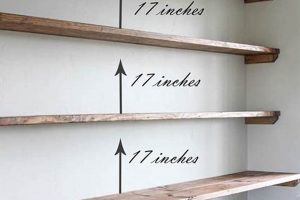The installation of decorative panels on the lower portion of an interior wall, often reaching approximately half its height, represents a popular home improvement technique. This approach to wall enhancement involves various materials, designs, and methods undertaken by homeowners themselves, foregoing professional installation services. It offers a customized and potentially cost-effective approach to interior design. For instance, a homeowner might choose to install beadboard paneling to a living room wall, enhancing its aesthetic appeal and adding a layer of protection to the drywall.
The application of this technique contributes significantly to a room’s aesthetic character, offering visual interest and depth. Historically, it served a functional purpose, protecting walls from furniture and everyday wear. Beyond its protective qualities, it provides an opportunity to introduce texture, color, and architectural detail. The practice can elevate the perceived value of a home, creating a more polished and sophisticated interior environment. Moreover, the satisfaction derived from completing such a project can be a significant benefit for the homeowner.
Subsequently, this article will delve into the various materials suitable for achieving this decorative effect, the necessary tools and techniques for successful installation, and strategies for planning and executing a paneling project to ensure a professional-looking outcome. Considerations regarding design choices, cost implications, and potential challenges will also be addressed.
Installation Tips for Half Wall Paneling
The following guidelines are designed to facilitate a successful and aesthetically pleasing installation of decorative panels on the lower section of interior walls. Adherence to these suggestions can minimize errors and maximize the longevity and visual impact of the finished project.
Tip 1: Precise Measurement and Planning: Prior to commencing any physical work, accurate measurements of the wall surfaces are essential. Develop a detailed plan outlining the panel layout, considering factors such as door frames, electrical outlets, and other architectural features. This proactive approach minimizes material waste and ensures a cohesive design.
Tip 2: Material Selection Based on Environment: Select paneling materials appropriate for the room’s environment. For bathrooms or kitchens, moisture-resistant options such as PVC or treated wood are preferable to prevent water damage and maintain structural integrity.
Tip 3: Proper Wall Preparation: Ensure the existing wall surface is clean, smooth, and free of imperfections. Patch any holes or cracks with appropriate filler and sand the surface until it is level. Priming the wall prior to panel installation can improve adhesion and provide a uniform base for the paneling.
Tip 4: Accurate Cutting Techniques: Employ precision cutting techniques to ensure panels fit snugly against each other and adjacent surfaces. A miter saw with a fine-tooth blade is recommended for achieving clean, accurate cuts. Consider using a laser level to ensure consistent horizontal alignment.
Tip 5: Secure Attachment Methods: Utilize appropriate adhesives and fasteners to securely attach the panels to the wall. Construction adhesive, combined with finishing nails or screws, provides a robust and durable bond. Ensure fasteners are countersunk to prevent protrusion and facilitate seamless finishing.
Tip 6: Professional Finishing Touches: After installation, caulk all seams and gaps with paintable caulk to create a seamless appearance and prevent moisture intrusion. Sand any rough edges and apply multiple coats of paint or sealant, allowing each coat to dry thoroughly before applying the next.
Tip 7: Account for Existing Trim: If the room already features baseboards or other trim, plan the paneling height in relation to these elements. A harmonious integration with existing architectural details enhances the overall aesthetic appeal.
Adhering to these guidelines can result in a professionally executed project, enhancing the aesthetic appeal and value of the home while ensuring long-term durability.
In conclusion, following these tips can help reduce issues and improve success when completing the paneling project in a half-wall method.
1. Accurate Measurements
Precise dimensional assessment forms the foundational basis for any successful installation of decorative panels on the lower section of interior walls. Its role extends beyond simple quantification; it dictates the uniformity, aesthetic appeal, and structural integrity of the completed project.
- Calculating Panel Requirements
Determining the precise quantity of paneling material requires accurate measurement of the wall area to be covered. Overestimation leads to unnecessary material costs, while underestimation results in project delays and potential inconsistencies in the final appearance. Calculations must account for door frames, windows, and other architectural interruptions. Real-world examples include measuring each wall section independently and accounting for waste generated during cutting. Accurate calculation ensures a streamlined project, reduced costs, and minimizes the risk of material shortages.
- Ensuring Uniform Height
Maintaining a consistent panel height across the installation is crucial for visual harmony. Variations in height disrupt the intended aesthetic and create an unprofessional appearance. Measurements must be taken at multiple points along the wall to identify and compensate for any existing unevenness in the floor or ceiling. A laser level can aid in establishing a consistent horizontal reference point. Consider the appearance of panels in relation to doors or windows for the purpose of maintaining symmetry on the wall, it will enhance the overall look.
- Accounting for Architectural Features
Door frames, electrical outlets, and other architectural elements require precise measurements to ensure a seamless integration with the paneling. Inaccurate measurements can lead to panels that do not fit properly around these features, resulting in unsightly gaps or overlapping edges. Precise marking and cutting techniques are essential for achieving a clean and professional finish. The end results will increase the value and give professional look.
- Mitigating Material Waste
Accurate measurements minimize material waste by optimizing panel placement and reducing the need for corrective cuts. A detailed plan based on precise measurements allows for efficient material utilization and reduces the environmental impact of the project. Planning material cutting and use can reduce waste and protect the environment for the material used.
The interconnectedness of these measurement facets underscores the fundamental importance of accuracy in paneling projects. By meticulously addressing each element, the homeowner can avoid costly errors, achieve a superior aesthetic outcome, and ensure the longevity and structural integrity of the finished installation. Consider an advanced planning for the benefit of the project.
2. Material Selection
The choice of materials directly impacts the aesthetic, durability, and long-term maintenance requirements of decorative panels installed on the lower section of interior walls. The selection process is not merely an aesthetic consideration but a critical determinant of the project’s overall success. The inherent properties of the chosen material influence its resistance to moisture, impact, and general wear, thereby dictating its suitability for specific environments. For instance, solid wood panels offer a classic aesthetic but are prone to warping and damage in high-humidity areas, rendering them unsuitable for bathrooms or kitchens. Conversely, Medium Density Fiberboard (MDF), while cost-effective, possesses a lower resistance to moisture compared to solid wood or PVC alternatives. Therefore, a deliberate alignment between the material’s characteristics and the intended application is paramount.
The practical significance of material selection is further exemplified by the variance in installation techniques required for different materials. Solid wood panels typically necessitate the use of nails and adhesives, demanding precise carpentry skills. MDF panels often benefit from the use of specialized fasteners to prevent splitting. PVC panels, due to their inherent flexibility, may require additional support during installation to maintain a straight and even surface. Furthermore, the finishing requirements differ significantly across materials. Solid wood may necessitate staining and sealing, while PVC panels are often pre-finished, simplifying the installation process. Failure to account for these material-specific installation and finishing nuances can compromise the integrity and aesthetic of the finished paneling.
In summary, material selection is a central element of lower wall paneling projects, exerting a direct influence on the final result. Careful consideration of the material’s properties, installation requirements, and finishing needs is essential for achieving a durable, aesthetically pleasing, and cost-effective outcome. Neglecting this critical step can lead to premature failure, increased maintenance costs, and a compromised visual appearance, ultimately detracting from the intended value and appeal of the installation.
3. Surface Preparation
Effective surface preparation is an indispensable prerequisite for the successful installation of decorative panels on the lower section of interior walls. It provides the foundational base upon which the aesthetic appeal, durability, and longevity of the finished project rest.
- Cleaning and Degreasing
The removal of dirt, dust, grease, and other contaminants from the wall surface is essential for ensuring proper adhesion of paneling adhesives. Residual contaminants can compromise the bond between the panel and the wall, leading to potential detachment or instability over time. Cleaning agents appropriate for the existing wall surface should be employed, followed by thorough rinsing and drying. The failure to adequately clean and degrease the wall surface constitutes a significant risk factor in paneling installations.
- Repairing Imperfections
Any cracks, holes, or unevenness present on the wall surface must be addressed prior to panel installation. These imperfections can create unsightly gaps between the panel and the wall, detracting from the visual appeal of the finished project. Furthermore, they can compromise the structural integrity of the paneling installation. Appropriate patching compounds should be used to fill any imperfections, followed by sanding to create a smooth and uniform surface.
- Priming the Surface
The application of a primer coat to the prepared wall surface serves multiple purposes. It enhances the adhesion of the paneling adhesive, seals the existing wall surface, and provides a uniform base for the paneling. Priming also helps to prevent the absorption of moisture from the adhesive into the wall, ensuring a stronger and more durable bond. A primer formulated for the specific type of wall surface and paneling adhesive should be selected.
- Ensuring a Smooth and Level Surface
The ultimate goal of surface preparation is to create a smooth and level surface upon which the paneling can be installed. Variations in the wall surface can result in uneven panel alignment, unsightly gaps, and a compromised aesthetic appearance. The use of a level and straightedge is recommended to verify the flatness of the wall surface prior to panel installation. Shimming or furring strips may be required to correct any significant unevenness.
Adequate surface preparation, encompassing cleaning, repair, priming, and leveling, forms the cornerstone of a successful paneling installation. Neglecting these essential steps can result in a compromised aesthetic appearance, reduced durability, and potential long-term maintenance issues. Attention to detail during surface preparation ensures a professional-looking finished product with enhanced longevity.
4. Precise Cutting
The relationship between meticulous cuts and successful decorative panel installation on the lower section of interior walls is one of direct cause and effect. Without accurate and clean cuts, panels will not align properly, resulting in visible seams, gaps, and an overall unprofessional appearance. The importance of precise cutting becomes particularly acute when dealing with intricate panel designs or when fitting panels around architectural elements such as door frames, windows, and electrical outlets. For example, a beveled edge cut incorrectly can prevent panels from meeting flush, negating the aesthetic enhancement the bevel was intended to provide. The degree of precision directly translates to the quality of the finished aesthetic; inaccurate cutting negates the benefits of careful planning and material selection.
Further emphasizing the practical significance, consider the impact of imprecise cuts on material usage. Poor cutting techniques invariably lead to material waste, increasing project costs and potentially causing delays if additional material must be acquired. Mitre saws equipped with fine-tooth blades, coupled with accurate measurement and marking tools, are essential for achieving the required precision. The use of templates for complex shapes or angles further enhances accuracy. In real-world scenarios, a homeowner attempting to install tongue-and-groove paneling without precise cuts will likely encounter difficulty interlocking the panels correctly, leading to instability and a compromised finish.
In conclusion, precise cutting is not merely a technical aspect of decorative lower wall paneling installation; it is a fundamental requirement for achieving a visually appealing and structurally sound result. The challenges associated with imprecise cuts include increased material waste, compromised aesthetics, and potential structural instability. Mastering accurate cutting techniques is crucial for any homeowner undertaking this type of project, linking directly to the project’s ultimate success and long-term value.
5. Seamless Finishing
The attainment of a seamless finish represents the culminating stage in the execution of decorative lower wall paneling, exerting a disproportionate influence on the overall aesthetic appeal and perceived value of the project. It encompasses a series of meticulous techniques designed to eliminate visible transitions and imperfections, creating a unified and cohesive surface that integrates seamlessly with the surrounding environment.
- Caulking and Filling
The application of caulk or filler to seams, gaps, and fastener holes is a critical step in achieving a seamless finish. These materials effectively conceal imperfections, preventing the intrusion of moisture and creating a smooth, continuous surface ready for painting or other finishing treatments. Failure to adequately caulk and fill these areas results in visible discontinuities that detract from the overall aesthetic quality. For example, gaps along the top edge of the paneling or around door frames can be filled with paintable caulk, creating an invisible transition between the paneling and the wall. Such actions create uniformity across the paneling.
- Sanding and Smoothing
Sanding plays a crucial role in creating a flawless surface for subsequent finishing. It removes any irregularities, such as raised edges or excess filler, ensuring a smooth and uniform texture. Different grits of sandpaper may be required to achieve the desired level of smoothness. For example, sanding the filled nail holes in MDF paneling with fine-grit sandpaper creates a seamless surface prior to priming and painting. A uniform wall can provide a better viewing expereince.
- Priming and Painting
Priming the paneling provides a uniform base for the final coat of paint, enhancing adhesion and ensuring consistent color coverage. The application of multiple coats of high-quality paint, with appropriate drying time between coats, further enhances the finish, creating a durable and aesthetically pleasing surface. The choice of paint color and finish can significantly impact the overall aesthetic. For instance, a semi-gloss finish may be selected for its durability and ease of cleaning, while a matte finish may be preferred for its understated elegance. Painting provides an extra protection in the long run.
- Trim and Molding Integration
The seamless integration of trim and molding elements, such as baseboards, chair rails, and corner pieces, is essential for a professional-looking finished product. Trim and molding should be carefully selected to complement the paneling style and should be installed with precision to create a cohesive and visually appealing design. For instance, installing a chair rail along the top edge of the paneling can create a defined transition between the paneling and the upper portion of the wall, adding a touch of architectural detail. Molding completes the process.
The pursuit of a seamless finish in decorative lower wall paneling represents a commitment to quality and attention to detail. By meticulously executing each of these techniques, the homeowner can transform a functional paneling installation into a striking design element that enhances the aesthetic appeal and value of the home. Seamless finishing should be a priority.
Frequently Asked Questions
The following questions address common concerns and misconceptions regarding the installation of decorative panels on the lower section of interior walls, undertaken as a DIY project. The responses aim to provide clear and informative guidance.
Question 1: What is the expected lifespan of paneling installed in this manner?
The longevity of the paneling is contingent upon material selection, installation quality, and environmental conditions. Durable materials, properly installed and maintained, can reasonably be expected to last for a decade or more. Exposure to excessive moisture or physical damage, however, can significantly shorten its lifespan.
Question 2: How does this type of paneling affect the resale value of a home?
When executed skillfully and harmoniously integrated with the home’s overall design, this paneling can enhance its aesthetic appeal and potentially increase its resale value. Poorly installed or stylistically incongruous paneling, conversely, may have a negative impact. Ensure consistency with the architectural style.
Question 3: What are the primary safety considerations during installation?
Safety precautions should include the use of appropriate personal protective equipment (PPE), such as safety glasses and gloves. Power tools must be operated in accordance with manufacturer instructions, and electrical circuits should be de-energized prior to working near outlets or wiring. Ensuring a safe environment is critical.
Question 4: Is specialized expertise required to undertake such a project?
While prior experience in carpentry or home improvement is beneficial, a novice can successfully complete such a project with careful planning, meticulous execution, and adherence to established best practices. Thorough research and preparation are essential prerequisites.
Question 5: What is the approximate cost of materials for a typical room?
Material costs vary widely depending on paneling material, room size, and design complexity. Budget estimates should encompass the cost of panels, adhesives, fasteners, caulk, paint, and any necessary tools or accessories. A detailed materials list is recommended for estimating the financial resources required.
Question 6: What are the potential drawbacks or challenges associated with this type of installation?
Potential challenges include inaccurate measurements, uneven wall surfaces, difficulties in cutting and fitting panels around architectural features, and achieving a seamless finish. Thorough preparation, meticulous execution, and the willingness to address unforeseen issues are critical for mitigating these challenges.
The key takeaways are proper planning, material selection, and execution are paramount for achieving a successful and aesthetically pleasing outcome. Addressing potential challenges proactively can minimize complications and ensure a satisfactory result.
The article will delve into advanced techniques.
Conclusion
This exploration of diy half wall paneling has underscored the necessity of meticulous planning, material consciousness, and skillful execution. From accurate measurements to seamless finishing, each stage demands attention to detail and adherence to established best practices. Neglecting any component can compromise the aesthetic quality, structural integrity, and long-term value of the installation.
Ultimately, the decision to undertake diy half wall paneling necessitates a balanced assessment of one’s capabilities, resources, and the inherent complexities of the task. A successful outcome hinges upon a commitment to thorough preparation, skillful execution, and a proactive approach to addressing potential challenges. With diligence and precision, the transformative potential of diy half wall paneling can be fully realized.







